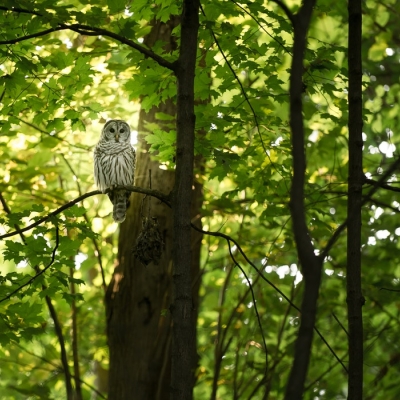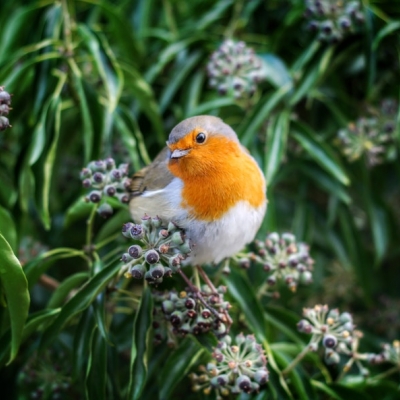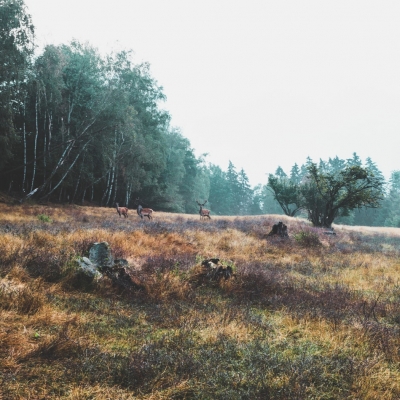
If you are 100% new, try renting a couple times. Start with a short, wide beginner boat, then try again in a faster boat once you are used to the feel of a kayak.
Some shops offer demo days to try different boats.
I too paddle calm waters generally, but I do appreciate being able to get a little speed going if the mood strikes. A lot of people get the hang of the sport very quickly, so don't undershoot on the boat. Sit on tops and ultra cheap big box store boats will go slow, and only slow. People seem to love recommending terrible boats sometimes because they are "safer" (you would be surprised how many times that suggest boats that aren't all that safe) and cheap. Speed and efficiency go hand-in-hand.
You may not need a fast boat, but you will definitely appreciate efficiency. If it looks like a bathtub or something rented out at family resorts, it probably paddles as well as a barge
The car part is easy. There are kits with foam blocks and straps that work very well once you get the hang of the proper tie-down technique. Roof racks are great if you have the money, but put most of your cash towards a decent boat and a decent paddle. Other than that:
- a comfy PFD
- water shoes
- a light source
- a water bottle
- sunscreen
- a wetsuite or waterproof jacket (depending on the where you live)
And not to forget a way to get back in your kayak when you're alone.
Take courses and learn what you are doing, kayaking is more challenging than you may think.

I walleye fish on the kayak all the time from my kayak, it is a lot of fun, and I get to be out on the water. I have used it all, and in it all works, you just have to know when to use it. I have caught them on crankbaits, shadraps, bucktail jigs tipped with worms.
Lately however I have been having the most success with jig and minnow.
And as I have heard it seems to be the way to go for walleye, and for basically every lake that you want to catch walleye on.
Usually pink, white, or half and half pink/white are the most productive color of jig heads. They need to be able to see it if you want them to take the bate.
Rivers
On rivers jigs work as well, but also I find that crankbaits work a little better in rivers than on lakes.
The main thing to consider regardless of what you are using for lures, is that you get the right depth.
Depth is one of the main problems people run into when they are fishing. No matter if it is walleye or any other type, you need to know the deth of water you are fishing in. That is why I use a fish finder.
Walleye like to sit on the bottom and when we jig we basically drop it till it hits bottom and then take up slack and pull it up an inch or two.
Techniques
A common technique is to pound the bottom. This is a technique I picked up from a good friend of mine who swore by the technique, and I have to admit it is a good one. When you pound, you baically get their attention. By raising the jig up a foot or two and letting it sink quickly to the bottom to hit and make a thud, then hold it an inch or two off again.
Do this every couple minutes and you will often get a strike as the jig is falling to the bottom or just after you hit the bottom and are raising it that inch or two.
Walleye have good eyesight, and are night time predators with excellent night vision so if you can be out later at dusk or into the night you will likely see more action, same with early morning.
The chances of success tend to die off during midday. While I have had some luck, you can still catch, it's just much harder.
Bait
In murky water use bright colors like pink, orange, bright green, white. In clearer water use more natural colors, silver, blues, browns, etc.
Also, be sure you have a nice sensitive rod. Walleye are notorious for having a 'soft' bite and often you will feel them nibble on the minnow a while before they actually take it.
If your rod is not sensitive enough you can often have your minnow stolen and never feel a thing.
Outings
I fish a big watersports lake in mine all the time, and during prime ski boat/powerboat/jetski season I just pretend nothing more than 50 feet off the shore exists.
They let any idiot with an ID and credit card rent a boat/jetski these days, so it's just not quite worth the risk to me to fish the islands or channels during the high time of year.
If you do cross big open water, I would recommend a couple of flags/reflectors on poles mounted to your boat so you stick out like a sore thumb.
I know some guys who like to fish for Walleye at night, so make like a Christmas tree if you do that... there are plenty of waterproof LED light strips/bars/spotlights you can rig up that will put out a lot of light without using a lot of juice. And always wear your PFD. Good luck and stay safe out there.

The charm of becoming a wildlife biologist is that there is so much room to grow. And if you are willing to evolve you can reach lofty heights.
While it's not the easiest path on the planet, you will have multiple hurdles standing in your way, as well as the physical aspects that play a role in this career. If you are aware of all of that, willing to over come them, then it is definitely possible to make a career of it. And there is no doubt that it can be a fulfilling job for the right person.
If you are just starting out make sure that you gain experience with:
- GPS
- densitometers
- compass work
- tree canopy height
- tree canopy cover estimation
- topo maps
- Understanding topo maps is the most important (imo) as is the ability to follow different protocols.
And while these are not crucial wildlife oriented skills, not in the same manner as the ones I just mentioned, they are important:
- hiking in rough terrain
- If you have or can acquire backpacking and unique hiking type experiences recreationally it can really help you get your foot in the door.
operating a 4 wheel drive vehicle
orienteerings skills
Acquiring Skills

I want to look at the different skills a little bit more and hopefully shine some light on areas that you may find interesting.
This is what everything comes down to. Are you dedicated?
- Show initiative early.
- Any type of effort/motion forwards regardless of the specific experience shows how intense your devotion is.
- This is a difficult field with a high dropout rate; show people you are serious.
- Think hard and decisively about how to stand out on paper.
- Over time you can paint a picture of your personality, intelligence, passion, and competency and make them your strongest attributes.
There are some universal skills as well as path-specific investments. Whether it's birds, mammals, fish, herpetofauna, habitat restoration, wetland based work et cetra.
Here are some areas to look at:
Universal Skills
Lots of jobs and a lot of wildlife tech positions are out of reach without general knowledge and experience.
An important thing to note is that it is very easy to get pigeon holed in this type of work because of it's relevance and the difficulties of lining up preferred seasonal jobs back to back.
- GIS- A rapidly developing field with high demand and universal applications to natural science fields.
- Wilderness Medicine-a Wilderness First Responder certification is an important supplementary skill.
- If Wilderness First Responder is too tall on an order, Wilderness First Aid is just as good in most circumstances.
- 4x4 and ATV operation and maintenance
- General outdoor skills in remote settings, extreme environments, and rough terrain.
- Data entry, analysis, examples of technical writing.
- Displayed skill and adaptability to different types of survey technologies. Some examples of what I mean are:
- water quality testing
- acoustic tech for bats
- electrofishing
- radio telemetry
- mist netting
- firearm safety and operation.
- Handling of wildlife
- You can approach this by volunteering at rehabilitation clinics, there are plenty of them around the country.
- Working at night is a skill in and of itself, and if you are comfortable in this situation you can also open a few doors.
Specific Skills
- If you will be working around any larger body of water or river, boat experience is a good skill to have. Here are some aspects to focus on:
- Outboard motor operation
- General oar/rowing experience.
- Boating license when necessary
- Complimentary to this would be a Swift Water Rescue Certification, this is similar to Wilderness First Responder.
- Use of spotting scopes and binoculars for bird related work.
- It's pretty easy to find low paying or volunteer work to get some bird experience.
- Vegetation sampling, habitat delineation/surveying, and/or plant identification in the respective ecosystem of interest.
- Travel or take specific coursework of relevance.
- The basic question here is show diversity, tolerance, and adaptive knowledge bases.
- Ornithology is a big employment field within wildlife biology and many volunteer positions are available everywhere.
From what I have seen networking with advisors and teachers has gotten pretty much all of my classmates their first job.


Forget All the Illusions
Forget all illusions and romantic stereotypes of working outside. Working outside is great and I really enjoy it, but you have to ask yourself are you the type of person who doesn't mind getting hot and sweaty in the piss pouring rain for 10 hours a day? Will you mind being knee deep in mud/animal shit or snow? Take a look at the climate you live in as you will have to be dealing with it everyday.
Scout the Job Market (First!)
Look for jobs you could get once you finish whatever course you plan to do. The trouble is that forestry is mainly carried out by the government, or at least influenced by it.
Unfortunately in times of budget cuts environmental issues are usually the first to go meaning that finding a job in the field is pretty hard here.
If you are in another country I have no idea what the job market would be like but it would definitely be some thing to look in to.
It Is A Science
Forestry is a scientific subject like any other, the question is "how can you make the most money in the quickest time".
You will see plantations where trees are grown and harvested like corn and work sites where the environment is mistreated just like the animals you mentioned. It seems like the industrial process of farming has put you off the Animal Science, but you'll often find the same sort of thing in forestry.
Conservation
A plant isn't just a plant. And so there are many different paths for you to take into the forest.
For example, conservation biology. There are schools with that major, offering courses that are specifically designed with conservation in mind.
Also conservation jobs usually judge experience on the same level as education, so I would really recommend volunteering with a local organisation. Luckily these types of organisation are pretty common and only too happy to have people aboard.
You have to remember that trees take a long time to grow and therefore forestry is a very slow process.
On the Other Hand
A lot of jobs in forestry deal with the cutting down and management of forests for economic use. In fact classifying forests and soils to be cut down is where the money is.
I don't want to discourage you. We need people that are going to look at and push for better practices, but the economic driver is cutting the trees down. If you don't like how production animals are treated, you may be in for a shock to understand how we treat our forests for production. It is what it is.
A lot of jobs rely on it.
The demand for wood is huge.

There are no minor accidents with a chainsaw. And no matter what you do, you can never be 100% safe when you work with them. One slip in judgement and you may have to live with the scars your whole life. Or you won't, in which case you will be dead.
Chainsaws are very dangerous and people who don't know how to work with them shouldn't work with them. Getting training, and learning what can go wrong will never be certain. Every situation is different and when you are out in the wild even a little injury (there are no minor accidents with a chainsaw) can cost you your life.
I wear full protective equipment every time I start one. I look like a total dork, but I don't care.
That means hard hat, chaps, the works.
The chainsaw "chaps" actually will have "strings" of fabric pull out of them that will hopefully clog the sprocket in the saw. While I will admit that having protective clothing that use strings to clog the sprocket sounds a little bit crude, it is effective. These strings will jam the sprocket, and make the clutch slip. The chain stops. In this fashion the pants stop the cutting before the can get through. You may be bruised (in most cases you will be), but you shouldn't get cut.
The helmet with face protection should stop a kickback. And that can be deadly if it strikes you in the shoulder. Training can help here, as it will show you how important body position is.
When cutting, have the saw positioned so if it kicks straight up, it will be to your right-hand side. Instead of cutting in front of you, where it would kick into your face/shoulder. If something bad does happen there is little gurantee that you will escape all injury. Nine times out of ten the answer is, probably not, but if everything goes "right" (there is no right in an accident) you will hopefully be less hurt.
I have seen this first hand, and I can attest to the danger of a saw that is not actively being used. The majority of injuries with a chainsaw happen after the throttle has been released.
Usually taking a step immediately after making a cut.
People have died and lost limbs while engine rpm has been winding down. Most chainsaws rev out to over 13k rpm.
This means that you could easily saw through a 2x4 with a chainsaw after you let go of the throttle. My father made the mistake of letting his guard down and only suffered a tearing cut that ran down the length of his left thigh. The cut was mostly cosmetic so he was one of the lucky ones.
Things could have went very differnt for him.
He was wearing jeans.

Don't cheap out on your life jacket. They vary greatly in quality. But the biggest issue is comfort. That may sound odd but if its comfortable you will wear it and the best life jacket is the one you wear. Try one on in the store and then look online for a possible better deal to ensure sizing and fit.
There are lifejackets designed for kayaking that don't ride up when you sit down and are cut in a way that allows free movement of your arms without rubbing and chafing.
Some people will suggest a paddle leash, and while they may sound like a good idea, I'd advise against a paddle leash, especially in moving water - where one of the main hazards is entrapment. Getting entangled in anything in moving water is pretty much a death sentence.
As far as which kayak, which is your biggest piece of equipment, it really depends on your budget and the water you'll be on.
If you intend to fish a lot, or get in and out of the boat frequently, you may consider a sit on top, rather than a sit in.
There are numerous brands and designs, and I would recommend you find a local store where someone knows what the water is like and can recommend a good starter boat based on that. Do a couple a kayak trips, rent a kayak or kayaking test trips. My local shop does test days where you can try over 30 different kayaks.
Try out quite a few before you buy one so that you understand the different feel that the avialable styles have to offer. Generally speaking boats that are sold in big-box stores are only suitable for lakes and slow rivers. They are designed to be easy to get in and out of and easy to handle without training, but that comes with a huge cost in terms of control and capability.















